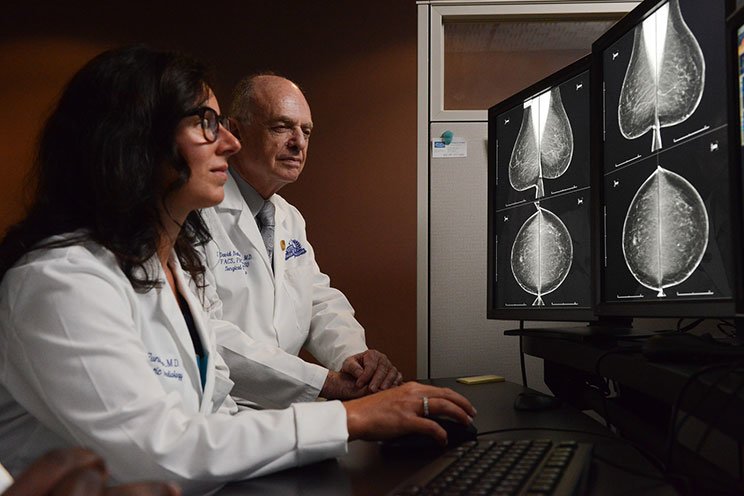Expert Breast Cancer Care
We give patients access to the top surgeons and the most advanced science-based technologies and treatments.

Jessica Linders received a life-changing diagnosis in December 2017 — she had invasive and fast-growing, lobular breast cancer and a genetic mutation, called BRCA 2. Her treatment would include a double (bilateral) mastectomy and surgery to remove her ovaries and fallopian tubes.
“The first thing I asked myself was ‘why me?’” says Jessica, who ate healthy foods and did daily fitness workouts.
With an open mind and a positive attitude, Jessica, 41, evaluated her choices about breast reconstruction. Her surgeon, Dunya Atisha, M.D., director of Breast Reconstruction and Microsurgery at Henry Ford Health, explained that during the double mastectomy, temporary tissue expanding implants would be inserted into her chest cavity.
Option one: Use implants that would expand when weekly injections of saline were given while in the doctor’s office.
Option two: Use implants that would expand with air. No needles. No weekly visits to the doctor. In the convenience of her home, Jessica could use a remote-controlled device to gradually fill the implants with 10 cc’s or more of carbon dioxide a few times a day. Designed to provide women with more independence, the implants — AeroForm AirXpanders — also reduce the risk of infection from needle-sticks.
“It was a done deal,” Jessica says. “Just knowing I didn’t have to have another needle stuck in my chest helped me make the decision.”
Jessica was a good candidate to use the air expanders because she had the desire to follow directions and the willpower to do the expansion process at home, says Dr. Atisha.
“The air-expansion process eliminates fear and anxiety for many patients,” says Dr. Atisha. “A lot of women hear or read horror stories about tissue expansion. For some women, the process of weekly saline injections can feel tight and painful for 24-72 hours.
“But if the patient controls the process, it is less painful. The woman regulates how much air is used and on what days it is used. Patients can pump themselves up a little each day, or they can take a break for a day or two.
“This technology revolutionizes the expansion process,” says Dr. Atisha.
“Dr. Atisha had built a great rapport and got to know me as a person,” says Jessica. “I would trust her with any decision about my breast reconstruction process.”
Currently, the plastic surgeons at Henry Ford are the only physicians in Michigan that offer air expanders to their patients.
Air expanders are one of the many breast cancer care innovations now available at the Henry Ford Cancer Institute, including:
Before Jessica could complete her reconstructive process, however, she underwent chemotherapy and radiation therapy. Tissue expansion is typically done before radiation therapy. That’s because radiation can act like a sunburn and may cause skin to tighten.
The process of gradually expanding the skin was a simple one:

“It was cool that I could wave a medical wand over my breast and control the air flow as I expanded myself,” says Jessica. “It’s a little like blowing up a balloon. You can see the expansion and feel a little of the air pressure.”
She says that she was expanded in four weeks — faster than the average saline breast implant patient. One research study showed that saline expansions can take a median of 46 days.
Expansion varies depending on the size of the woman, the amount of air used each week, and the patient’s comfort level. “Everybody’s experience is different,” says Dr. Atisha.
Did the expansion process hurt?
Jessica laughed, “The only time it was painful was when the doctor expanded me the first time with 30 cc’s of air after surgery. I went from being big busted, to flat, and then to being expanded.” After the expansion process is complete, the average patient will continue to have the expander implants in place for five months. Patients who need chemotherapy and radiation will retain the implants for 9-12 months.

We give patients access to the top surgeons and the most advanced science-based technologies and treatments.
We use cookies to improve your website experience. By using this site, you agree to our Terms of Use. Read our Internet Privacy Statement to learn what information we collect and how we use it.